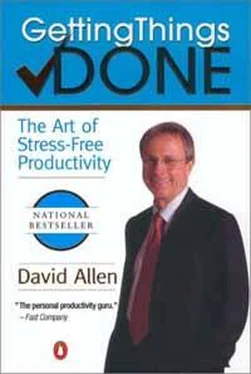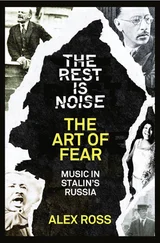For many of the executives I work with, holding the world back for two contiguous days is the hardest part of the whole process— the perceived necessity to be constantly available for meetings and communications when they're "at work" is difficult for them to let go of. That's why we often resort to weekends. If you work in an open cubicle or office, it will be even more of a challenge to isolate sufficient time blocks on a regular workday during office hours.
It's not that the procedure itself is so "sacred"; it's just that it takes a lot of psychic energy to collect and process such a large inventory of open loops, especially when they've been "open," "undecided," or "stuck" for way too long. Interruptions can double the time it takes to get through everything. If you can get to ground zero in one contained time period, it gives you a huge sense of control and accomplishment and frees up a reservoir of energy and creativity. Later on you can maintain your system in shorter spurts around and "between the lines" of you regular day.
Dedicate two days to this process, and it will be worth many times that in terms of your productivity and mental health.
Setting Up the Space
You'll need a physical location to serve as a central cockpit of control. If you already have a desk and office space set up where you work, that's probably the best place to start. If you work from a home office, obviously that will be your prime location. If you already have both, you'll want to establish identical, even inter-changeable systems in both places.
The basics for a work space are just a writing surface and room for an in-basket. Some people, such as a foreman in a machine shop, an intake nurse on a hospital floor, or your children's nanny, won't need much more than that. The writing sur face will of course expand for most professionals, to include a phone, a computer, stacking trays, working file drawers, reference shelves. Some may feel the need for a fax, a printer, a VCR, and/ or multimedia conferencing equipment. The seriously self-contained will also want gear for exercise, leisure, and hobbies.
A functional work space is critical. If you don't already have a dedicated work space and in-basket, get them now. That goes for students, homemakers, and retirees, too. Everyone must have a physical locus of control from which to deal with everything else.
If I had to set up an emergency workstation in just a few minutes, I would buy a door, put it on top of two two-drawer filing cabinets (one at each end), place three stack-baskets on it, and add a legal pad and pen. That would be my home base (if I had time to sit down, I'd also buy a stool!). Believe it or not, I've been in several executive offices that wouldn't be as functional.
If You Go to an Office, You'll Still Need a Space at Home
Don't skimp on work space at home. As you'll discover through this process, it's critical that you have at least a satellite home system identical to the one in your office. Many people I've worked with have been somewhat embarrassed by the degree of chaos that reigns in their homes, in contrast to their offices at work; they've gotten tremendous value from giving themselves permission to establish the same setup in both places.
You must have a focused work space—at home, at work, and if possible even in
If you're like many of them, you'll find that a week-end spent setting up a home workstation can make a revolutionary change in your ability to organize your life.
An Office Space in Transit
Ifyou move around much, as a business traveler or just as a person with a mobile life-style, you'll also want to set up an efficiently organized micro-office-in-transit. More than likely this will consist of a briefcase, pack, or satchel with appropriate folders and portable workstation supplies.
Many people lose opportunities to be productive because they're not equipped to take advantage of the odd moments and windows of time that open up as they move from one place to another, or when they're in off-site environments. The combination of a good processing style, the right tools, and good interconnected systems at home and at work can make traveling a highly leveraged way to get certain kinds of work done.
Don't Share Space! It
is imperative that you have your own work space—or at least your own in-basket and a physical place in which to process paper. Too many married couples I've worked with have tried to work out of a single desk at home, and it always makes light-years of difference when they expand to two workstations. Far from being the "separation" they expect, the move in fact relieves them of a subtle stress in their relationship about managing the stuff of their shared lives. One couple even decided to set up an additional mini-workstation in the kitchen for the stay-at-home mom, so she could process work while keeping an eye on their infant in the family room.
Some organizations are interested in the concept of "hoteling"—that is, having people create totally self-contained and mobile workstation capabilities so they can "plug in" anywhere in the company, at any time, and work from there. I have my doubts about how well that concept will work in practice. A friend who was involved in setting up an "office of the future" model in Washington, D.C., for the U.S. government, claimed that hoteling tended to fall apart because of the "Mine!" factor—people wanted their own stuff. I suggest there's a deeper reason for the failure: there needs to be zero resistance at the less-than-conscious level for us to use the systems we have. Having to continually reinvent our in-basket, our filing system, and how and where we process our stuff can only be a source of incessant distraction.
It is critical that you have your own work space. You want to use your systems, not just think about them.
You can work virtually everywhere if you have a clean, compact system and know how to process your stuff rapidly and portably. But you'll still need a "home base" with a well-grooved set of tools and sufficient space for all the reference and support material that you'll want somewhere close at hand-when you "land." Most people I work with need at least four file drawers for their general-reference and project-support types of paper-based materials—and it's hard to imagine that all of that could ever be totally and easily movable.
Getting the Tools You'll Need
If you're committed to a full implementation of this workflow process, there are some basic supplies and equipment that you'll need to get you started. As you go along, you're likely to dance between using what you're used to and evaluating the possibilities for new and different gear to work with.
Note that good tools don't necessarily have to be expensive. Often, on the low-tech side, the more "executive" something looks, the more dysfunctional it really is.
The Basic Processing Tools
Let's assume you're starting from scratch. In addition to a desktop work space, you'll need:
• Paper-holding trays (at least three)
• A stack of plain letter-size paper
• A pen/pencil
• Post-its (3X3s)
• Paper clips
• Binder clips
• A stapler and staples
• Scotch tape
• Rubber bands
• An automatic labeler
• File folders
• A calendar
• Wastebasket/recycling bins
Paper-Holding Trays
These will serve as your in-basket and out-basket, with one or two others for work-in-progress support papers and/or your "read and review" stack. The most functional trays are the side-facing letter or legal stackable kinds, which have no "lip" on them to keep you from sliding out a single piece of paper.
Читать дальше











